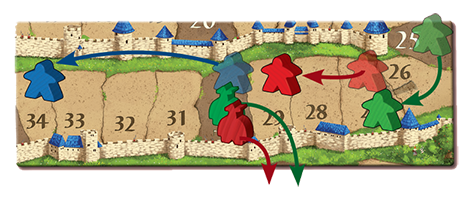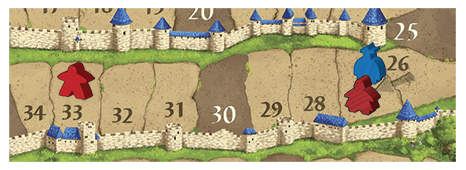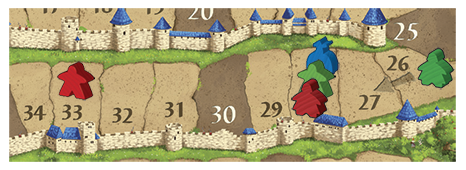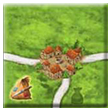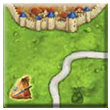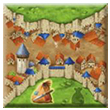Difference between revisions of "The Robbers/fr"
| Line 91: | Line 91: | ||
[[File:Robbers_C2_Example_03.png|frame|none|''{{ColorBlue|Blue}} marque 4 points. {{ColorRed|Rouge}} et {{ColorGreen|Vert}} marquent chacun 2 points grâce à leurs pions Voleur, qui retournent ensuite dans leur réserve.'']] | [[File:Robbers_C2_Example_03.png|frame|none|''{{ColorBlue|Blue}} marque 4 points. {{ColorRed|Rouge}} et {{ColorGreen|Vert}} marquent chacun 2 points grâce à leurs pions Voleur, qui retournent ensuite dans leur réserve.'']] | ||
===== {{ColorBlue|Évaluation finale}} ===== | |||
==== Évaluation finale ==== | |||
Lorsqu'un pion Voleur se trouve encore sur la piste de score à la fin de la partie, il rapporte '''3 points''' à son propriétaire, après quoi il retourne dans sa réserve. | Lorsqu'un pion Voleur se trouve encore sur la piste de score à la fin de la partie, il rapporte '''3 points''' à son propriétaire, après quoi il retourne dans sa réserve. | ||
Revision as of 23:32, 25 September 2020
Informations générales et commentaires
Les voleurs (Mini #6) a été commercialisé pour la seconde édition par Hans im Glück en Template:Year fr, regroupé au sein de la Big Box 6.
Des bandes de voleurs rôdent et exigent leur tribut. Lorsque des partisans marquent des points,ces "bonnes âmes" viennent leur tenir la main.
Matériel
- 6 pions Voleur
Règles
Mise en place
Mélangez les tuiles Terrain de cette extension aux autres tuiles Terrain utilisées pour la partie. Chaque joueur ajoute le pion Voleur de sa couleur à sa réserve.
Déroulement du jeu
1. Placement d'une tuile
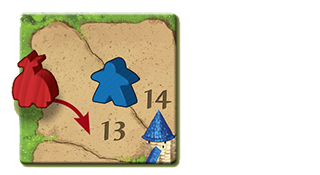
2. Placement d’un meeple
Vous pouvez maintenant poser un meeple ou un autre pion sur la tuile selon les règles habituelles[4].
3. Évaluation des zones
"Voler" des points
Lorsque le pion Score d'un joueur quitte la case qu'il occupait avec votre pion Voleur pour marquer de nouveaux points, vous recevez grâce à votre voleur la moitié des points (arrondir à l'entier supérieur) acquis par cet autre joueur[5] [6]. L'autre joueur marque bien la totalité des points, qui lui sont attribués. Vous marquez les points volés en avançant votre pion Score sur la piste et récupérez votre pion Voleur qui retourne dans votre réserve.
Règles complémentaires :
- Le pion voleur que vous avez posé sur la même case que le pion Score d'un autre joueur, suit ce dernier lorsque celui-ci avance sur la piste de score grâce à des "points volés" (les voleurs ne se volent pas entre eux !) pour pouvoir lui voler des points par la suite. Vous ne marquez pas la moitié des "points volés" récupérés par ce joueur, mais restez sur ses talons en attendant la prochaine occasion.
- Vous êtes obligés d'accepter les points qui vous sont attribués grâce à votre pion Voleur (en dehors des "points volés"). Vous ne devez pas attendre l'éventualité de gagner plus lors d'une prochaine évaluation[7].
- Si plusieurs pion Score occupant le même case que votre pion Voleur devaient avancer sur la poste de score dans le même tour, vous pourriez choisir le joueur à qui voler la moitié des points[8] [9] [10] [11].
- Si les pions Score de différents joueurs occupent la case d'un pion Score d'un autre joueur qui va marqué des points, tous ces joueurs marquent la moitié des points grâce à leur voleur.
- Vous ne pouvez pas voler votre propre pion Score.
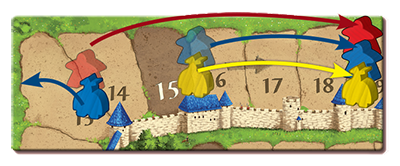
Évaluation finale
Lorsqu'un pion Voleur se trouve encore sur la piste de score à la fin de la partie, il rapporte 3 points à son propriétaire, après quoi il retourne dans sa réserve.
Interactions avec les autres extensions
Si vous jouez avec d’autres extensions, veuillez prendre en considération les remarques suivantes :
 Les Hérauts :
Les Hérauts :
If either your messenger or your scoring meeple lands on a dark space as a result of your robber stealing points from another player, draw a message tile.
Exemples détaillés de l'utilisation des pions Voleur et des Meeplettes
Example #1
The blue robber is on the same space as your messenger. Your scoring meeple is on a different space. With placement of one tile, you score points for both a road (3 points) and a city (6 points.)
Each feature is scored separately. You decide which of your scoring figures moves on the scoring board. The blue player only receives "robber points" for the first movement of the scoring figure that stands on the same space as the blue robber – here your messenger.
One of the following 4 options can happen :
- First, your messenger scores 3 points for the road. After that, your scoring meeple scores 6 points for the city. Then the blue robber robs half of the points from the your messenger (2 Points.)
- First, your scoring meeple scores 3 points for the road. After that, your messenger scores 6 points for the city. Then the blue robber robs half of the points from the your messenger (3 Points.)
- First, your messenger scores 3 points for the road. After that, your messenger scores 6 points for the city. Then the blue robber robs half of the points for the road (the first score) from the your messenger (2 Points.) [12]
- First, your scoring meeple scores 3 points for the road. After that, your scoring meeple scores 6 points for the city. Here, the blue robber robs nothing from you because your scoring meeple was not on the same space as the blue robber.
Example #2
The blue robber is on the same space as the green scoring meeple and your messenger. The other scoring figures for the green player and you are standing on different spaces. With placement of one tile, the green player scores points for a road (3 points) and you score points for a city (6 points.)
The blue robber is on a space occupied by more than one scoring figure, and both of the scoring figures (more than one) are scoring points. Thus, the blue robber chooses which player he will "rob" half of the points from. The green player and you can choose which of their scoring figures move when points are scored. The blue robber can only receive points from a scoring figure that stands on the same space.
One of the following 3 options can happen :
- The green player and you both decide to score with your scoring figures that are standing on the same space as the blue robber. The blue robber decides to rob the half of the points from your messenger (3 Points.)
- The green player decides to score with the green scoring meeple and you also decide to score with your scoring meeple. The blue robber can only rob the half of the points from the green scoring meeple (2 Points) since your scoring meeple is not on the same space as the blue robber.
- The green player and you both decide to score with your scoring figures that are standing on different spaces from the blue robber. The blue robber can't rob any points from the green messenger or your scoring meeple, as the blue robber isn’t on the same space as either one of them.
Example #3
The blue robber is on the same space as the green scoring meeple, the green messenger, and your scoring meeple. Your messenger stands on a different space. With placement of one tile, the green player scores points for a road (3 points) and for a city (6 points), and you score points for a road (2 points) and for a city (8 points.)

- The blue robber, the green scoring meeple, the green messenger, and your scoring meeple share the same space.
- Your messenger is on a different space.
- The green player scores points for a road (3 points) and for a city (6 points), and you score points for a road (2 points) and for a city (8 points.)
Each feature scores separately. The green player and you can choose which of your scoring figures will score the points. The blue robber can only receive points from a scoring figure that stands on the same space as the blue robber. In this case, the blue robber can definitely receive points from the green player, because both scoring figures from the green player are on the same space. The blue robber’s ability to rob points from you will depend on which figure(s) you choose to move. Since the blue robber is on a space occupied by more than one scoring figure, and more than one figure is scoring points, the blue robber chooses which player he is "robbing" half the points from. The blue robber gets all of the information that he/she needs about movement from the other players (you and the green player) before making the best decision about which points to rob.
One of the following 3 options can happen:
- The green player and you each score with one of the scoring figures that was standing on the same space as the blue robber. They both decide to score their roads first. The green player first scored the road worth 3 points with the green messenger. You then scored the road worth 2 points with your scoring meeple. The blue robber decided to rob half of the points from the green messenger (2 points), because robbing from your scoring meeple would have only been worth 1 point.
Since both the green player and you chose to score your cities second with the same figures, the blue robber could not get half of the points from either city. The blue robber could only choose to rob the first green points or your first points available. If, however, the green player had scored the city with the green scoring meeple, the blue robber could have robbed half of those points, since that would have been yet another scoring figure to choose to rob from. - You decide to first score the road worth 2 points with your messenger, which does not stand on the same space as the blue robber. The green player first scores the road worth 3 points with the green messenger. You then use your scoring meeple to score the city worth 8 points. The blue robber decides to rob half of the points from your scoring meeple (4 points), because there were only 2 points available from the green messenger.
- You decide to first score the road worth 2 points with your messenger, which does not stand on the same space as the blue robber. Then you also score the city worth 8 points with your messenger. The green player first scores the city worth 6 points with the green scoring meeple. The blue robber can only rob half the points from the green scoring meeple (3 points) because your messenger is not standing on the same space as the blue robber.
Example #4
The blue robber and the yellow robber are on the same space as the green scoring meeple, the green messenger, and your scoring meeple. Your messenger stands on a different space. With the placement of one tile, the green player scores points for a road (3 points) and for a city (6 points), and you score points for a road (2 points) and for a city (8 points.)
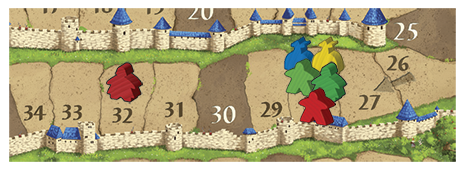
- The blue robber, the yellow robber, the green scoring meeple, the green messenger, and your scoring meeple share the same space.
- Your messenger is on a different space.
- The green player scores points for a road (3 points) and for a city (6 points), and you score points for a road (2 points) and for a city (8 points.)
Each feature scores separately. The green player and you can choose which of your scoring figures will score the points. The blue robber and yellow robber can only receive points from a scoring figure that stands on the same space that each of them is on. In this case, the blue robber and the yellow robber can definitely receive points from the green player, because both scoring figures from the green player are on the same space. The robbers’ ability to rob points from you will depend on which figure(s) you choose to move. Since the blue robber and the yellow robber are on a space occupied by more than one scoring figure, and more than one figure is scoring points, each robber chooses which player he is "robbing" half the points from. The blue robber and the yellow robber get all of the information that they need about movement from the other players (you and the green player) before making the best decision about which points to rob.
One of the following 3 options can happen:
- The green player and you each score with one of the scoring figures that was standing on the same space as the blue robber and the yellow robber. They both decide to score their roads first.
The green player first scored the road worth 3 points with the green messenger. You then scored the road worth 2 points with your scoring meeple. The blue robber decided to rob half of the points from the green messenger (2 points), and the yellow robber decided to rob from your scoring meeple (1 point.) Why choose to take fewer points? If yellow is the active player and can receive a message, this makes more sense. - You decide to first score the road worth 2 points with your messenger, which does not stand on the same space as the robbers. The green player first scores the road worth 3 points with the green messenger. You then use your scoring meeple to score the city worth 8 points. The blue robber and the yellow robber each decide to rob half of the points from your scoring meeple (4 points), because there were only 2 points available from the green messenger.
- You decide to first score the road worth 2 points with your messenger, which does not stand on the same space as the robbers. Then you also score the city worth 8 points with your messenger. The green player first scores the city worth 6 points with the green scoring meeple. The blue robber and the yellow robber can only rob half the points from the green scoring meeple (3 points) because your messenger is not standing on the same space as the robbers.
Ensemble des tuiles
Total Tiles: 8
Les tuiles individuelles ayant la même présentation de base peuvent différer.
Plusieurs tuiles comportent une petite illustration. Les lettres entre parenthèses indiquent l’illustration qui se trouve sur chaque tuile :
Notes
Pour les licences et les explications des icônes, veuillez visiter la page des icônes.
- ↑
 Si vous jouez avec l'extension Les Hérauts, le voleur peut être placé à côté soit d'un pion Score, soit sur la meeplette. Ainsi, le voleur peut obtenir des points de l'un ou l'autre des pions Score, mais seulement de celle qui se trouve sur la même case que le voleur. (5/2013)
Si vous jouez avec l'extension Les Hérauts, le voleur peut être placé à côté soit d'un pion Score, soit sur la meeplette. Ainsi, le voleur peut obtenir des points de l'un ou l'autre des pions Score, mais seulement de celle qui se trouve sur la même case que le voleur. (5/2013)
- ↑
 Les règles de ZMG ont modifié cette phrase ils ont modifié cette phrase pour indiquer que "dans l'ordre de leur tour, chaque joueur place son voleur sur la piste de score, en choisissant également les cases occupées par les pion Score des autres joueurs." Cette divergence peut être due à une mauvaise traduction.
Les règles de ZMG ont modifié cette phrase ils ont modifié cette phrase pour indiquer que "dans l'ordre de leur tour, chaque joueur place son voleur sur la piste de score, en choisissant également les cases occupées par les pion Score des autres joueurs." Cette divergence peut être due à une mauvaise traduction.
- ↑
 La légende de cet exemple a été modifiée par ZMG pour correspondre à la règle modifiée de placement des voleurs
La légende de cet exemple a été modifiée par ZMG pour correspondre à la règle modifiée de placement des voleurs
- ↑
 Les pions de cette extension ne sont pas placés sur les tuiles Terrain standard dans le cadre du jeu
Les pions de cette extension ne sont pas placés sur les tuiles Terrain standard dans le cadre du jeu
- ↑
 Le voleur peut recevoir des points de La Roue de la Fortune ou par les points gagnés grâce à la fée. (5/2013)
Le voleur peut recevoir des points de La Roue de la Fortune ou par les points gagnés grâce à la fée. (5/2013)
- ↑
 Si le voleur se trouve sur une case avec un pion Score qui se déplace vers l'arrière (par exemple, suite au paiement d'un bazar ou d'une rançon de tour), le voleur se déplace vers l'arrière avec l'évaluation, mais le joueur qui possède le voleur ne perd pas de points. (3/2015)
Si le voleur se trouve sur une case avec un pion Score qui se déplace vers l'arrière (par exemple, suite au paiement d'un bazar ou d'une rançon de tour), le voleur se déplace vers l'arrière avec l'évaluation, mais le joueur qui possède le voleur ne perd pas de points. (3/2015)
- ↑
 Chaque événement d'évaluation est distinct des autres - chaque zone est évaluée individuellement. Le voleur doit prendre des points seulement de la première' événement autorisé - points de zone unique, point de fée, points de catapulte, points de la Roue de la Fortune, etc. (5/2013)
Chaque événement d'évaluation est distinct des autres - chaque zone est évaluée individuellement. Le voleur doit prendre des points seulement de la première' événement autorisé - points de zone unique, point de fée, points de catapulte, points de la Roue de la Fortune, etc. (5/2013)
- ↑
 Si un seul pion Score se déplace plusieurs fois en raison de l'évaluation de plusieurs zones avec le placement d'une seule tuile, le joueur qui reçoit les points choisit l'ordre dans lequel les points sont attribués. S'il y a un voleur à côté de cette figure, le propriétaire du voleur recevra donc la moitié des points de la seule zone qui a été évaluée. Bien entendu, si plusieurs pions Score sur la même case reçoivent des points, le propriétaire du voleur peut toujours choisir la figurine à laquelle il veut dérober des points. (mai 2013, novembre 2014)
Si un seul pion Score se déplace plusieurs fois en raison de l'évaluation de plusieurs zones avec le placement d'une seule tuile, le joueur qui reçoit les points choisit l'ordre dans lequel les points sont attribués. S'il y a un voleur à côté de cette figure, le propriétaire du voleur recevra donc la moitié des points de la seule zone qui a été évaluée. Bien entendu, si plusieurs pions Score sur la même case reçoivent des points, le propriétaire du voleur peut toujours choisir la figurine à laquelle il veut dérober des points. (mai 2013, novembre 2014)
- ↑
 Bien que cette règle concerne l'évaluation de plusieurs chiffres dans "le même tour", le voleur ne peut pas nécessairement attendre la fin du tour complet pour savoir si elle s'applique. Le voleur ne peut prendre en compte que les événements qui se produisent simultanément, c'est-à-dire pendant le même "tour de pointage" (voir l'extension |Les Hérauts pour plus d'informations). Par exemple, l'évaluation des fées est distincte de celle des zones normales. Ainsi, si le voleur a pu marquer un point grâce à la fée, il doit prendre ce point ; il ne peut pas attendre d'autres événements plus tard dans le tour. (octobre 2014)
Bien que cette règle concerne l'évaluation de plusieurs chiffres dans "le même tour", le voleur ne peut pas nécessairement attendre la fin du tour complet pour savoir si elle s'applique. Le voleur ne peut prendre en compte que les événements qui se produisent simultanément, c'est-à-dire pendant le même "tour de pointage" (voir l'extension |Les Hérauts pour plus d'informations). Par exemple, l'évaluation des fées est distincte de celle des zones normales. Ainsi, si le voleur a pu marquer un point grâce à la fée, il doit prendre ce point ; il ne peut pas attendre d'autres événements plus tard dans le tour. (octobre 2014)
- ↑
 Si un voleur se trouve sur la même case que les pions Score de 2 autres joueurs, et que l'un de ces pions marque des points en volant un autre joueur (points "volés") alors que l'autre joueur ne marque rien, le voleur doit se déplacer avec la figure plutôt que de rester derrière. (Le point 1 de la règle s'applique ici, mais pas le point 3, car un seul pion Score marque des points). (mai 2014)
Si un voleur se trouve sur la même case que les pions Score de 2 autres joueurs, et que l'un de ces pions marque des points en volant un autre joueur (points "volés") alors que l'autre joueur ne marque rien, le voleur doit se déplacer avec la figure plutôt que de rester derrière. (Le point 1 de la règle s'applique ici, mais pas le point 3, car un seul pion Score marque des points). (mai 2014)
- ↑
 Si le voleur se trouve sur une case avec plusieurs pions Score et que l'un d'eux se déplace vers l'arrière (par exemple, à partir du paiement d'un bazar ou de la rançon d'une tour), le joueur qui possède le voleur peut choisir de soit déplacer le voleur vers l'arrière avec ce chiffre d'évaluation soit garder le voleur au même endroit que le(s) autre(s) pion(s) Score. (mars 2015)
Si le voleur se trouve sur une case avec plusieurs pions Score et que l'un d'eux se déplace vers l'arrière (par exemple, à partir du paiement d'un bazar ou de la rançon d'une tour), le joueur qui possède le voleur peut choisir de soit déplacer le voleur vers l'arrière avec ce chiffre d'évaluation soit garder le voleur au même endroit que le(s) autre(s) pion(s) Score. (mars 2015)
- ↑
 You could have chosen to score the city first, in which case the blue robber would score 3 points. However, it is unlikely that doing that would be in your best interest.
You could have chosen to score the city first, in which case the blue robber would score 3 points. However, it is unlikely that doing that would be in your best interest.
- Editor Manual - Old numbered parameters - RulesPlacingTile
- Editor Manual - Old numbered parameters - RulesPlacingMeeple
- Editor Manual - Old numbered parameters - RulesScoring
- Editor Manual - Old numbered parameters - Tile
- Old template
- Old template - FootnoteIconPara fr
- Under Construction
- Seconde édition
- Extension mineure de la seconde édition




